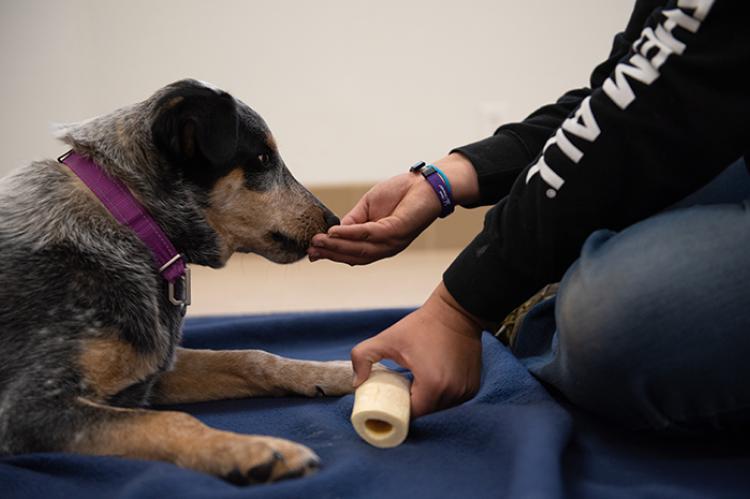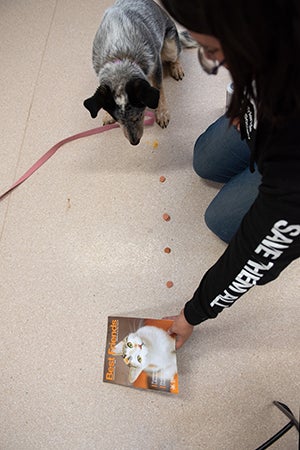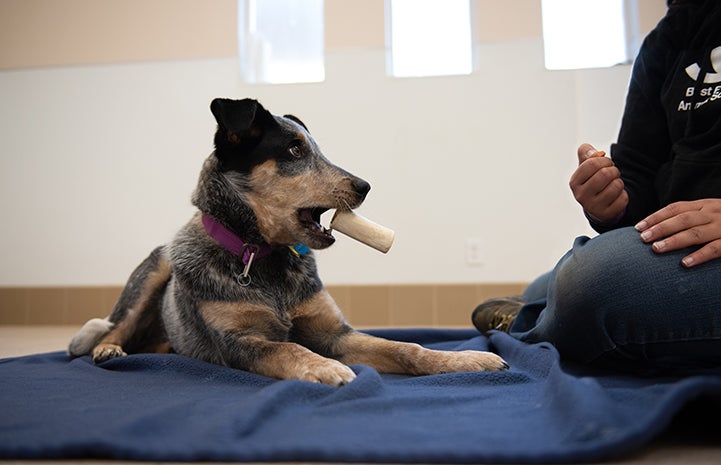How to Teach a Dog to Trade

Many of us have been involved in an inadvertent game of “keep away” with our dogs — when the dog snatches something and then refuses to give it up. It can be comical but also frustrating or even dangerous if the dog has grabbed a hazardous item. But if you teach your dog to trade, they’ll be more likely to give up the item. This can even work for dogs who have resource guarding issues.
Resource guarding in dogs
Resource guarding in dogs is a common and natural behavior, but many dog bites happen because of it. Practicing trades with your dog can help the dog feel better about having their stuff taken away. Implementing this dog training cue can reduce or eliminate a dog’s guarding behavior, keeping the dog and everyone around safe. It can also help to prevent dogs from guarding resources in the first place.
In addition, practicing trades can help with dogs who aren’t exhibiting true guarding behavior but rather are simply enthusiastic about grabbing for a toy in your hand or reluctant to drop a toy during a game of fetch. They can learn to politely exchange toys instead.
Before you begin, assess your dog’s level of guarding. If they are guarding rooms/spaces, do not show warning signs, or have already bitten, please consult a trainer.

Steps to teach a dog to trade
Use the following steps to teach a dog to trade.
- You’ll need a low-value item — something the dog hasn’t shown any signs of guarding. It can be a dog toy that your pup doesn’t much care for or an item they've never shown interest in, such as a book. You’ll also need a large supply of high-value treats.
- With a leash, tether the dog to a door or a sturdy piece of furniture, and place the low-value item within the dog’s reach. While the goal is to work at a level at which the dog feels safe and comfortable, the tether creates a way for you to move away from the dog if they do show any resource-guarding behaviors. Signs of resource guarding include avoidance, freezing, lip curling, growling, lunging, and snapping.
- Offer your dog some high-value treats. As they're eating, remove the low-value item. If they show interest in you taking away the low-value item, try making a trail of treats leading away from the item. Repeat this step a few times before moving on to the next step.
- In this step, the trade is simultaneous. Offer the dog high-value treats in one hand while removing the low-value item with your other hand. Repeat this step until the dog is excited about your approach and disengages from the low-value item on their own.
- Now, approach the dog, remove the low-value item, and then offer the treats. If the dog shows no signs of guarding, repeat this step multiple times, waiting a few seconds before offering the treats. If the dog does not seem excited about your approach, go back to step 4.
- Practice the above steps with a variety of items that the dog hasn’t shown any signs of guarding. You’ll want to work your way up gradually to more valuable items. The progression could be a toy that the dog isn’t very interested in, then a toy they sometimes play with, then a favorite toy (e.g., an empty Kong or one containing some low-value treats), and finally a much-coveted toy (e.g., a Kong filled with peanut butter or canned food). Remember, if at any point your dog does not have an excited response to your approach, go back to step 4.
- To help the dog understand that trading can be done anywhere and with anyone, practice in different places and with different people, starting with step 2 for each new location or person. The more you practice, the quicker the dog should be able to progress through each step.
The adage “use it or lose it” applies here, so practice trading often to maintain the dog’s skill.
Alternate method for teaching trades
Some dogs go from zero to 60 when it comes to the value they place on objects; they go from having no interest to extreme interest. With these dogs, it can be difficult to find low- and medium-value items. If that’s the case with your dog — or if you’re working with a dog who has a guarding history and you feel unsafe taking any object from them — try the following adapted training plan.
- Give the treats first, far enough away from the object that you can take the object away without fearing for your safety. Wait until the dog is eating the treats before removing the object. As soon as the dog is done with the treats, give the object back. Repeat this step only a few times, just long enough for the dog and you to get comfortable playing this game.
- Take the object and give the treats at the same time. As soon as the dog is done with the treats, give the object back. Again, repeat this step only a few times, just long enough for the dog and you to get comfortable playing this game. Note: These two steps should happen very quickly within the same training session.
- Proceed to the first step of the method above.
If you get stuck on any step, stop and take a break. When you try again, go back to the previous step in the plan. If necessary, create intermediate steps with intensity and duration that your dog is comfortable with. Don’t rush; take it at the dog’s speed.

Working with a dog trainer
If the dog shows any serious guarding behaviors, stop the training sessions and find a force-free, reward-based dog trainer with whom you can work.
Until this training is complete, make sure the dog never gets access to any high-value objects they shouldn’t have. If your dog does get something that you need to take away, distract the dog with treats first, far enough away from the object that you can take it without fearing for your safety. Wait until the dog is eating the treats before removing the object. Furthermore, teach children never to go near any dog who is eating or has any object (even a toy).
To keep training fun for your dog and help maintain focus, take frequent breaks and don’t rush. The process of teaching a dog to trade should happen over the course of many training sessions.